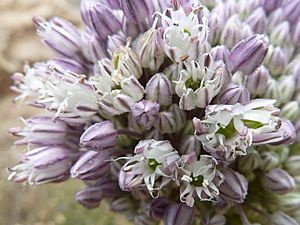Wild leek facts for kids
Quick facts for kids Wild leek |
|
|---|---|
 |
|
| Conservation status | |
| Scientific classification |
Allium ampeloprasum is a plant that belongs to the onion family, called Allium. You might know it better as wild leek or broadleaf wild leek. This plant originally comes from southern Europe and western Asia. However, people grow it in many other places, and it has spread naturally to many countries around the world.
Where Wild Leek Grows
Wild leek is native to all the countries that touch the Black, Adriatic, and Mediterranean Sea. This includes places from Portugal all the way to Egypt and Romania. In Russia and Ukraine, it is usually seen as a plant that has spread from other places, except in Crimea, where it naturally grows.
It also grows naturally in Ethiopia, Uzbekistan, Iran, and Iraq. You can find it growing wild in the United Kingdom, Ireland, the Czech Republic, the Baltic States, Belarus, the Azores, Madeira, the Canary Islands, Armenia, Azerbaijan, Pakistan, China, and most parts of Australia. It has also spread to Mexico, the Dominican Republic, Puerto Rico, Haiti, parts of the United States (like California and New York), the Galápagos, and Argentina. In a place called York County in Virginia, USA, this plant is even protected by law!
Some people think that wild leek was brought to Britain by people who lived there a very long time ago. In Britain, it often grows in rocky areas near the coast in south-west England and Wales.
Different Kinds of Leek
Allium ampeloprasum is special because it has been grown and changed by people into several different vegetables we eat today. The most well-known ones are:
- leek: This is a popular vegetable with a long, white stem and green leaves.
- elephant garlic: This looks like a very large garlic clove but tastes milder, more like an onion.
- pearl onion: These are small, round onions often used whole in cooking.
- Kurrat (also called Egyptian leek or salad leek): This type has small bulbs, and people mostly eat its leaves, which taste a bit like onion.
- Persian leek (Allium ampeloprasum ssp. persicum): This plant is grown in the Middle East and Iran. Its long, green leaves have a mild onion flavor and are often eaten raw.
What Wild Leek Looks Like
Wild leek plants that grow naturally have bulbs that can be up to 3 centimeters (about 1.2 inches) wide. The plant's main stem, called a scape, can grow very tall, up to 180 centimeters (about 6 feet!). At the top of this stem, there's a cluster of flowers called an umbel, which can have as many as 500 tiny flowers.
These flowers are shaped like urns and are about 6 millimeters (0.2 inches) across. Their petals, called tepals, can be white, pink, or red. The parts that hold pollen, called anthers, can be yellow or purple, and the pollen itself is yellow.
-
Spathe unfurling to reveal buds
See also
 In Spanish: Allium ampeloprasum para niños
In Spanish: Allium ampeloprasum para niños






